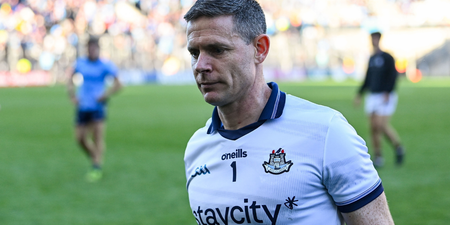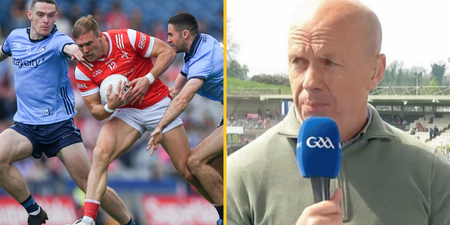Typically, even amidst a massacre, you can find some sort of incisive pattern relating to a glitch somewhere. This one was so comprehensive, however, it’s not so easy.
At a stretch, there are still a few things which we can take from a one-sided Leinster semi-final regarding Dublin. With regards to Westmeath, however, or a comparison with how Carlow fared, and how a minnow can try to stifle the big gun, there were a number of things to learn.
Dublin’s short kick-outs
Among other things, there’s a reason why Down shocked Monaghan on Saturday. If you’re not pressing the opposition high up the field, the logical things to do is to completely drop off to the halfway line, at least.
Up until two years ago, Monaghan and Donegal were two of the handful of sides doing it efficiently, giving them huge tactical advantages over most others. Now, almost every side is doing it. Down and Carlow, for example, have become two of an increasing number. Westmeath have not.
Down simply dropped off en masse
Dublin went short to the full-back line or half-back line on 17 kick-outs and scored a massive 2-9 off those kicks. Those are kick-outs where Westmeath typically kept a spare man at the back and allowed Stephen Cluxton the option of finding a free man on the kick-outs!
Even from the seven of these kick-outs that weren’t kicked quickly, Dublin scored five points from seven. Typically, these are difficult kick-outs to score from because the opposition are set up well behind the ball.
The primary reason for such a high score kick-out-to-score ratio was that Westmeath didn’t press high up the field, but neither did they drop off the way Down, Monaghan, Tyrone, Donegal, Sligo and Galway have all done, systematically, this year.
They kept a man at the back and tried to split the Dublin kick-outs. In its own right this isn’t a bad strategy. The problem was that when they lost the Dublin kick-outs, and they lost 100 percent, they tried to sort of, but not properly, press that area, and were outnumbered.
That meant that Dublin could easily weave their way through their own half and frequently the middle third.
So instead of Westmeath having their defence set up like the aforementioned sides have done, they had players in the middle third taken out of the game, and found themselves playing catch-up at the back.
Westmeath press despite there being an easy option forward for Dublin
Which puts three Westmeath men chasing, and Dublin with space to move into
Leaving Westmeath’s defence on the backfoot and Dublin attacking into more space
Allowing Con O’Callaghan receive the ball man-on-man, with ease
And kick over the bar
Westmeath’s long kick-outs
Contrary to how it may have seemed, Westmeath’s downfall was not down to how poorly they fared on their own kick-outs.
Yes indeed, they lost 24 and only won 11 of their own long kicks, but for the most part, the proportion of scores conceded off these kick-outs wasn’t as high as you might have imagined.
In fact, by the 65th minute, despite trailing by 2-23 to 0-9, they had, actually, conceded only six points off their own 18 long kick-outs lost, while scoring four points from the nine they had won!
If you counted the respective sides’ figures to include scores gained upon the first turnover after losing a long Westmeath kick-out, the sides had, in fact, scored six points each from this source after 65 minutes.
Dublin scored 1-4 from the remaining eight, but the point is that Westmeath had long been torn apart at a point where their net score for/against on their own long kick-outs was neutral.
From the two kick-outs Westmeath went short with they conceded a point upon first turnover on both, so it transpires that poor as their win/loss head to head was on long kick-outs, it definitely represented their best option.
Implications For Dublin
From a Dublin point of view, a score concession of four points from the 11 long Westmeath kick-outs they lost is maybe worthy of note.
A 34 percent kick-out to score concession ratio isn’t alarming as such, even against Division 4 opposition, but could perhaps allude to a structural issue, as they looked a little stretched at the back as soon as they lost a number of kick-outs.
Noteworthy for both sides is that from four of their own kick-outs that Westmeath won on breaks, they scored three points. From seven they won cleanly, they scored one point! That’s a 75 percent long kick-out to score ratio when they won it on break versus a 14 percent ratio when they won them cleanly.
The reason is simple. When Westmeath won them cleanly/on marks, Dublin saw the attack coming and set up a well-structured defence. When Dublin lost breaks which they competed for, their shape was compromised and they were stretched, allowing Westmeath more favourable attacking circumstances.
All three of these points saw a Westmeath forward attacking a corner-back man-on-man or kicking over uncontested at the end of the move.
Westmeath win the break off the kick-out
Dublin are quickly stretched with one hand-pass taking out four of their middle third
Before being stretched again at the back and conceding the score
It’s not an outrageously worrying pattern in its own right, but is worthy of note and keeping tabs on in their next game.
Blanket Defence Analysis
By any standards, however, Dublin had an exceptionally high ratio in terms of the amount of scores they earned relative to the amount of time they faced blanket defences.
The concern a Dublin supporter might have, as turned out to be the case in 2014, was that their high scoring, swashbuckling style could come undone if they face a side who wouldn’t allow them to create man-on-man attacks. Would they have the ability to weave their way through blanket defences?
This question, in fact, probably explains why Dublin have changed tack and now play far more “pick and poke” football.
The manner in which they came off the shoulder at perpendicular angles against Westmeath was brilliant and frequently left Westmeath men in their wake.
In total, Dublin faced a blanket defence 46 times and scored 4-22 from this, a 74 percent attack to point ratio, exceptionally impressive against any opposition.
Unusually, they tallied a lower ratio from man-on-man attacks, scoring six points from 11 sttacks. Noteworthy from a Westmeath defensive point of view is that nine of those 11 man-on-man attacks came directly off a long kick-out!
It was a shame that Westmeath so rarely managed to turn over Dublin as the Dubs attacked. They’re the first side I’ve seen this championship season who systematically kept two or three up front, which could potentially have allowed them to counter-attack quickly.
Westmeath defend but systematically leave three up front
The problem was that they rarely dispossessed Dublin as they attacked, and when they did they did, only once did they manage to break quickly enough to create a man-on-man attack.
Added to one other man-on-man attack they created off a long kick-out, they scored a point on both occasions they attacked man-on-man (measured when they crossed an imaginary line 60 metres from goal).
Dublin’s Score Concession
Probably the most significant element of Dublin’s defensive tactic so far is that it has been Jonny Cooper, and not Cian O’Sullivan, who has played sweeper. For the most part, he has done pretty well, contributing to low score concession.
Amidst a relatively low amount of scores conceded, especially after the 12th minute, there were still two patterns of note in Dublin’s defence.
Though still not as efficient as Tyrone in this regard, they significantly reduced the amount of scoreable frees conceded compared to the Carlow game. Their total concession was down from 11 to three.
More to the point, they significantly reduced the amount of frees conceded where no direct threat existed, to two.
Byrne gifts the free to a forward under pressure
While O’Sullivan fouls a pressured forward, running away from goal
With two such frees conceded by O’Sullivan against Carlow in the opening round, and one against Mayo in last year’s drawn final, it appears to be a pattern.
Dublin Defensive Frailties
As noted in their victory over Carlow, Ciarán Kilkenny is the only Dublin forward who has illustrated an ability to be able to drop seamlessly into defence. As Dublin, like all other sides, are perfectly prepared to filter at least 13 into defence, this is one thing which potentially raises alarm bells.
The manner in which Kevin McManamon was taken on and beaten for what could have been a very easy score, was all too easy, especially considering the fact that Dublin were perfectly well set up in defence at the time.
IMAGE 5A Dublin are perfectly well set up at the back
Before McManamon is taken on and easily beaten
And Westmeath earn a very scoreable shooting chance
By the same token, Niall Scully, playing at wing forward, conceded one very easy free which was converted when his man took him on directly and forced a scored free.
Conclusion
In the midst of as comprehensive a victory as you could hope for, there may have been inklings of a couple of potential Dublin frailties, elements which contenders for their title can potentially create small margins on.
Of course, even without Paul Flynn, Philly McMahon and Michael Darragh Macauley, everything else appears to be so efficient that it may well require more than small margins for even the closest of contenders to close that gap.
Stephen O’Meara is the creator and owner of www.gaaprostats.com, statistical and video analysis software designed specifically for Gaelic football and hurling.





















































